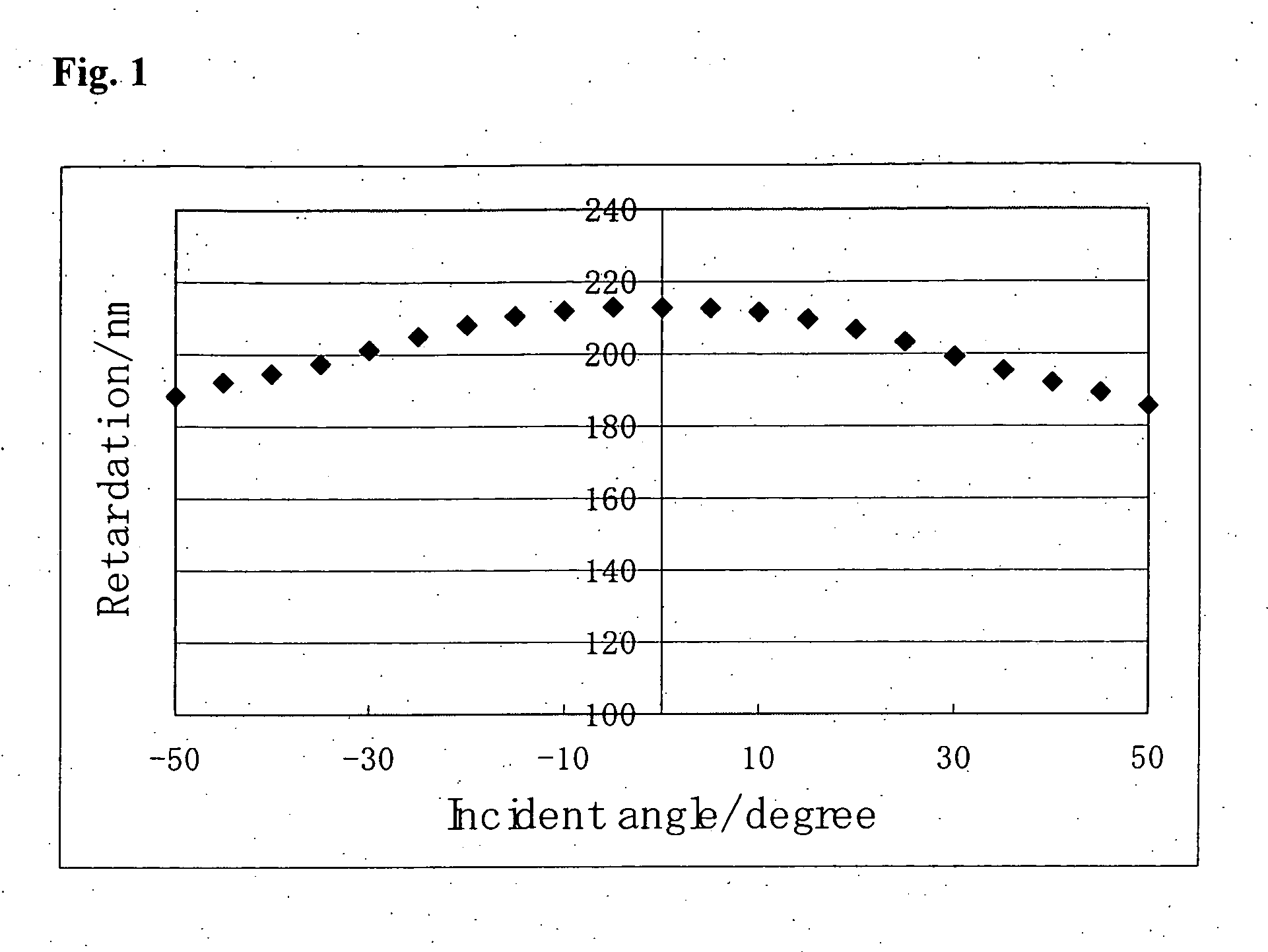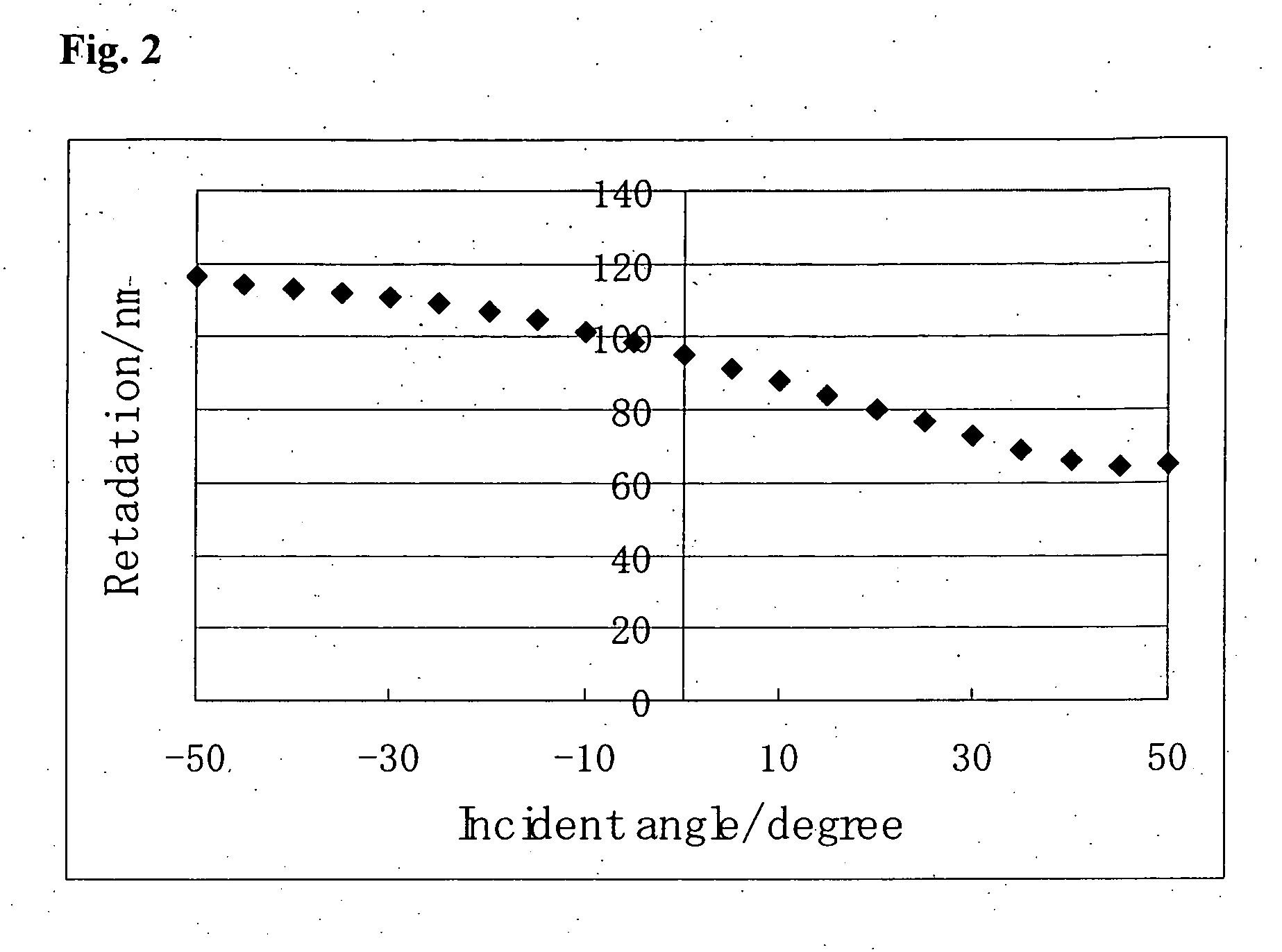Polymerizable liquid crystal composition and optically anisotropic film using the same
a technology of optical anisotropy and liquid crystal composition, which is applied in the field can solve the problems of poor solubility of polymerizable liquid crystal compound in such a solvent, difficult control of optical anisotropy by itself, and compound has a high melting point, so as to prevent the degradation of productivity and enhance the curing property. , the effect of regularity
- Summary
- Abstract
- Description
- Claims
- Application Information
AI Technical Summary
Benefits of technology
Problems solved by technology
Method used
Image
Examples
example 1
Preparation of Polymerizable Liquid Crystal Composition (1)
[0286]The compounds (1-28-2), (2-A2-11-A2) and (4-1-A2) were mixed at a weight ratio of 65 / 5 / 30. The resulting composition was designated as MIX 1. A polymerization initiator, Irgacure 907, available from Ciba Japan, Co., Ltd., in a weight ratio of 0.03 and a fluorine-related nonionic surfactant, FTX-218, available from Neos Co., Ltd., in a weight ratio of 0.002 were added to MIX 1. Propylene glycol monomethyl ether acetate (PGMEA) was added to the resulting composition to prepare a polymerizable liquid crystal composition (1) having a monomer concentration of 25% by weight.
[0287]Polyamic acid for a low pre-tilt angle (horizontal alignment mode) (Lixon Aligner PIA-5310, available from Chisso Corporation) was spin-coated on a glass substrate (S-1112, available from Matsunami Glass Industries, Ltd.), and after drying at 80° C. for 3 minutes, the coated film baked at 21° C. for 30 minutes, and then subjected to a rubbing treatm...
example 2
Preparation of Polymerizable Liquid Crystal Composition (2)
[0288]A polymerization initiator, Irgacure 907, available from Ciba Japan Co., Ltd., in a weight ratio of 0.03 was added to MIX 1 described in Example 1. Propylene glycol monomethyl ether acetate (PGMEA) was added to the resulting composition to prepare a polymerizable liquid crystal composition (2) having a monomer concentration of 25% by weight.
[0289]Polyamic acid for a high pre-tilt angle (OCB mode) (Lixon Aligner PIA-5580, available from Chisso Corporation) was spin-coated on a glass substrate (S-1112, available from Matsunami Glass Industries, Ltd.), and after drying at 80° C. for 3 minutes, the coated film baked at 210° C. for 30 minutes, and then subjected to a rubbing treatment with a rayon rubbing cloth. The polymerizable liquid crystal composition (2) was coated by a spin coating method on the glass substrate having the rubbed polyamic acid film. The substrate was heated to 80° C. for 3 minutes and cooled at room t...
example 3
Preparation of Polymerizable Liquid Crystal Composition (3)
[0290]A polymerization initiator, Irgacure 907, available from Ciba Japan Co., Ltd., in a weight ratio of 0.03 and the compound (5-1-1) (SILA-ACE S-330) in a weight ratio of 0.10 were added to MIX 1 described in Example 1. Propylene glycol monomethyl ether acetate (PGMEA) was added to the resulting composition to prepare a polymerizable liquid crystal composition (3) having a monomer concentration of 25% by weight.
[0291]Polyamic acid for a low pre-tilt angle (horizontal alignment mode) (Lixon Aligner PIA-5310, available from Chisso Corporation) was spin-coated on a glass substrate (S-1112, available from Matsunami Glass Industries, Ltd.), and after drying at 80° C. for 3 minutes, the coated film baked at 210° C. for 30 minutes. The polymerizable liquid crystal composition (3) was coated by a spin coating method on the glass substrate having the polyamic acid film without a rubbing treatment. The substrate was heated to 80° C...
PUM
| Property | Measurement | Unit |
|---|---|---|
| weight ratio | aaaaa | aaaaa |
| weight ratio | aaaaa | aaaaa |
| weight ratio | aaaaa | aaaaa |
Abstract
Description
Claims
Application Information
 Login to View More
Login to View More - R&D
- Intellectual Property
- Life Sciences
- Materials
- Tech Scout
- Unparalleled Data Quality
- Higher Quality Content
- 60% Fewer Hallucinations
Browse by: Latest US Patents, China's latest patents, Technical Efficacy Thesaurus, Application Domain, Technology Topic, Popular Technical Reports.
© 2025 PatSnap. All rights reserved.Legal|Privacy policy|Modern Slavery Act Transparency Statement|Sitemap|About US| Contact US: help@patsnap.com



